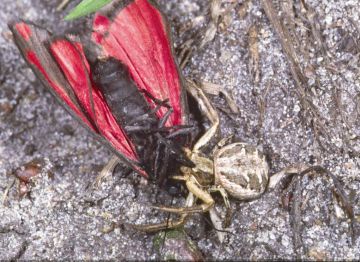Summary for Xysticus cristatus (Araneae)
previous species | next species
National Distribution
Terms of Use. Double-click on map to go to region

Explore Regional Distribution
Identification guidance for Xysticus cristatus
View notes or log on and add a note on this species
About this species
Recorded altitude range0m to 900m
Species text
DistributionThe species is widespread throughout most of Britain. It is widespread in western and central Europe.
Habitat and ecology
X. cristatus occurs in almost every habitat type, but is shade intolerant and rare in woodlands and closed canopy habitats. Large numbers can be found in grasslands and habitats which have undergone some degree of disturbance such as quarries and agricultural fields. In grasslands, this spider exploits a flexible hunting position either at the tips of vegetation or on the ground surface. As a consequence, the diet is extremely varied and comprises flying insects, including bees and butterflies, when positioned in flower-heads, or ants, spiders and other soft bodied prey when ambushing prey on the ground (Nyffeler & Breene 1990). Immatures have been found ballooning, particularly between the months of July to September (Freeman 1946). Adults have been recorded from February to December, with a male activity peak in May and June (Merrett 1967; Bell 1999).
Status
(Clerck, 1757) Status: Common.
Original author of profile: J.R. Bell
Text based on Harvey, P.R., Nellist, D.R. & Telfer, M.G. (eds) 2002. Provisional atlas of British spiders (Arachnida, Araneae), Volumes 1 & 2. Huntingdon: Biological Records Centre. References
Adult Season
Habitats
background methodology
Recorded management for locations with Xysticus cristatus
Recorded substrate and hydrology for locations with Xysticus cristatus
Images
please log on and upload a new image for this speciesSee also A-Z Species Index - A-Z Picture Index - previous species | next species









